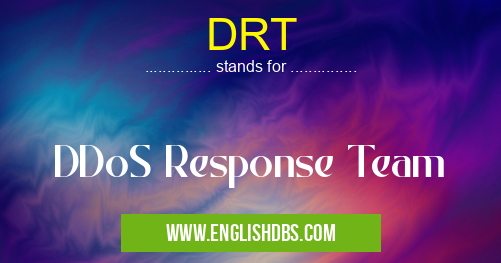What does DRT mean in UNCLASSIFIED
DRT stands for DDoS Response Team. It is a specialized team of security professionals responsible for responding to and mitigating distributed denial-of-service (DDoS) attacks. DDoS attacks are malicious attempts to overwhelm a website or online service with a flood of traffic, rendering it inaccessible to legitimate users.

DRT meaning in Unclassified in Miscellaneous
DRT mostly used in an acronym Unclassified in Category Miscellaneous that means DDoS Response Team
Shorthand: DRT,
Full Form: DDoS Response Team
For more information of "DDoS Response Team", see the section below.
Key Responsibilities of a DRT
- Monitoring and Detection: DRTs continuously monitor network traffic for suspicious activity that may indicate a DDoS attack.
- Incident Response: When a DDoS attack is detected, the DRT quickly mobilizes to mitigate the impact and restore service as soon as possible.
- Mitigation: DRTs use various techniques to mitigate DDoS attacks, including blackholing, rate limiting, and traffic scrubbing.
- Investigation and Analysis: DRTs investigate DDoS attacks to identify the source and gather evidence for potential prosecution.
- Prevention and Recovery: DRTs work with clients to implement preventive measures and develop recovery plans to minimize the impact of future DDoS attacks.
Importance of a DRT
DRTs play a crucial role in protecting organizations from the damaging effects of DDoS attacks. They provide:
- Rapid Response: DRTs can respond quickly to DDoS attacks, minimizing downtime and disruption.
- Expertise and Experience: DRTs possess specialized knowledge and experience in DDoS mitigation, ensuring effective and timely response.
- Peace of Mind: Having a dedicated DRT gives organizations peace of mind that they are prepared and equipped to handle DDoS attacks.
Essential Questions and Answers on DDoS Response Team in "MISCELLANEOUS»UNFILED"
What is a DDoS Response Team (DRT)?
A DRT is a specialized team of security professionals responsible for mitigating and responding to distributed denial-of-service (DDoS) attacks. They work to minimize the impact of DDoS attacks on an organization's infrastructure and services.
What are the typical responsibilities of a DRT?
The responsibilities of a DRT typically include:
- Monitoring for and detecting DDoS attacks
- Developing and implementing DDoS mitigation strategies
- Collaborating with ISPs and cloud providers to mitigate attacks
- Providing incident response support during DDoS attacks
- Conducting post-attack analysis and reporting
Why is having a DRT important for organizations?
Having a DRT is important for organizations because DDoS attacks can cause significant disruption to operations, resulting in:
- Loss of revenue
- Damage to reputation
- Reduced productivity
- Compliance violations A dedicated DRT can help organizations minimize these risks.
How can organizations benefit from engaging with a DRT?
Engaging with a DRT can provide organizations with:
- Expert guidance on DDoS mitigation and response
- Access to specialized tools and technologies
- Proactive monitoring and early detection of DDoS threats
- Faster and more effective incident response support
- Reduced business risks and improved resilience
What qualities should organizations look for when selecting a DRT?
When selecting a DRT, organizations should consider:
- Experience and expertise in DDoS mitigation
- Track record of success in responding to DDoS attacks
- Industry certifications and accreditations
- Availability and responsiveness
- Cost-effectiveness
Final Words: DRTs are essential for protecting organizations from the growing threat of DDoS attacks. Their expertise, experience, and rapid response capabilities ensure that businesses can maintain their online presence and minimize the impact of these malicious attempts.
